Hello, fellow lovers of all things green. I recently had the thrill of participating in a moth survey, thanks to my friends Blaine Rothauser of GZA Geoenvironmental, Inc. and Dennis Briede of Blairstown, NJ, whose meadow at the base of the Kittatinny Mountains harbors and nurtures abundant wildlife.

Blaine Rothhauser is capturing the images of the magnificent moths.
There are over 160,000 moth species worldwide, compared to 17,500 butterflies, and 11,000 kinds of moths are in the United States. Most moths are nocturnal, active at night, while butterflies are diurnal, active during the day. Both are essential pollinators.
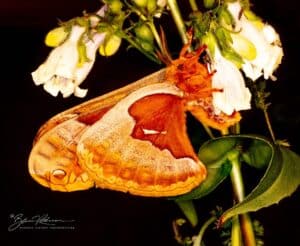
Tulip Tree Moth (Callosamia angulifera) Photo by: Blaine Rothhauser
Folks don’t consider moths beautiful. Other than, say, the Luna moth (Actias Luna), with its four to seven-inch lime green wingspan and stealth markings that look like eyes baffling bats, one of their greatest predators. Then there are Hummingbird Moths (Hemaris spp.), which look like hummingbirds and are active by day. But on the night of the moth count, I met many other stunning moths.
What is a Moth Survey?
Blaine describes the moth survey as “a recreational night of mothing, where we have fun just getting together with friends and family and people who love nature. Although, as scientists, we use these moth counts as indicators of ecological health.”
That evening, June 20th, he hoped to get at least 100 species of moths, but one night in July, they counted 228 in Dennis’s meadow – the second most Blaine had ever recorded in the state.
Blaine explains they set up a metal halide light— “a full spectrum light that has a magnetizing way of getting the insects that have to have a full spectrum to tax to it. Taxing is a fancy way of saying they come to the light.”
“We get the highest variety with this type of lighting system. But we also set up an ultraviolet light, which is attractive to certain species that aren’t attracted to full-spectrum lights. So when we fire up all these different lights, guess what, we get more species. Ah, and now it’s a moth party.”
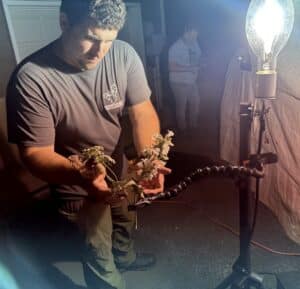
Steve Kloiber is setting up the “Plamp”
And what a moth party it was!
By 11:15, I was giddy with excitement over the 80 species of moths that visited, and I’ll bet the festivities went on to the wee hours of the morning. As quickly as the setup was in place, moths flocked to the screen, and Steve Kloiber rapidly wrote down each species by scientific name, swiftly maneuvering between the two lights set far apart.
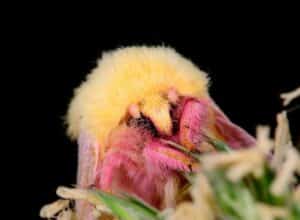
Rosy Maple Moth (Dryocampa rubicunda) Photo by: Blaine Rothhauser
Steve is an expert in identifying moths and is a mosquito authority. He works for Northampton County, PA, as an Environmental Health Coordinator of Vector Control, managing the populations of mosquitoes.
Of all the moths I met, the most fascinating, okay, funniest, was the Bird Poop Moth, also called the Beautiful Wood Nymph. Talk about clever camouflage to deter predators. They look precisely like bird droppings, complete with a white splatter and brownish streaks when they fold their wings.
A few favorite moths surveyed
There were so many lovelies, but my favorite was the Rosy Maple Moth. The cute pink and yellow fuzzy fellow stayed in my hand for several minutes. As the common name denotes, their preferred host is maple trees. But the most intriguing were the tiny moths, whose intricate details are only visible when you photograph and zoom in.
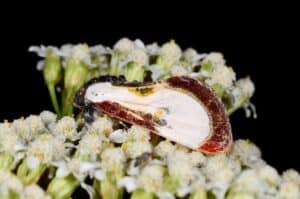
Bird Poop Moth, also called the Beautiful Wood Nymph (Eudryas grata). Photo By Blaine Rothhauser
Dennis’s favorite of the night was the Tuliptree Silk Moth. “Its size and its cryptic colors are great.” Callosamia angulifera is also known as the Giant Silk Moth, with a wingspan of 3 1/8 to 4 5/16 inches. They have large, angular white cell spots on their wings. The larvae feed on Tuliptrees (Liriodendron tulipifera).
Blaine emailed a few favorites, too.
“We saw an IO Moth at the end of the night,” also known as a Peacock Moth. Plus a tiger-like Orange-Headed Epicallima.
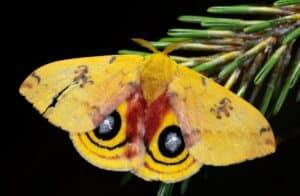
IO Moth (Automeris io) Photo by Blaine Rothhauser
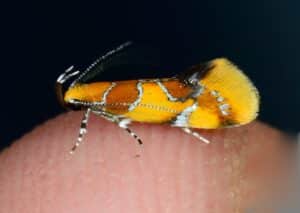
Orange-headed Epicallima Moth (Epicallima argenticinctella) Photo by Blaine Rothauser
Folks hire Blaine for moth parties with wine and cheese, and he’s off to the side. “They come and they go and learn a little bit.”
Thank you, Blaine and Dennis, for inviting me to take part in the festivities.
“Who would have thought you could have this much fun at night with your clothes on?” Smile.
I’d love to hear about critters you admire, perhaps some unusual to others. They all have a role in our Garden of Life.
Garden Dilemmas? AskMaryStone@gmail.com and your favorite Podcast App.
About Blaine Rothauser, Natural History Photographer, whose magnificent images are available to decorate your world.
Enjoy excerpts from the conversation in the Garden Dilemmas Podcast:

Dennis Briede is in his element in nurturing nature.
Related Stories you’ll enjoy:
Episode 100 Antics of Meadow Wildlife
Antics of Meadow Wildlife – Blog Post
Ep 101. Woodcock Dance-Making a Meadow
Woodcock Dance – Making a Meadow – Blog Post



Another very interesting episode, and the photos on the print version were beautiful as usual. Thank you for another educational and entertaining Sunday morning.
Thank you, Ken, for your kind words and for being an avid supporter of my column and podcast. Credit for the beautiful moth photos goes to Blaine Rothauser, an amazing photographer and naturalist. Thank you again, Mary
Amazing Night with an Amazing person – thanks for joining Mary and promulgating biodiversity!
Thank you, Blaine. You are a gift to those of us who wish to nurture nature – how you capture its mysteries and beauty in your artful photographs is a testament to your love and compassion for all the creatures we share life with. Thank you for sharing your wisdom and insights with us, Mary